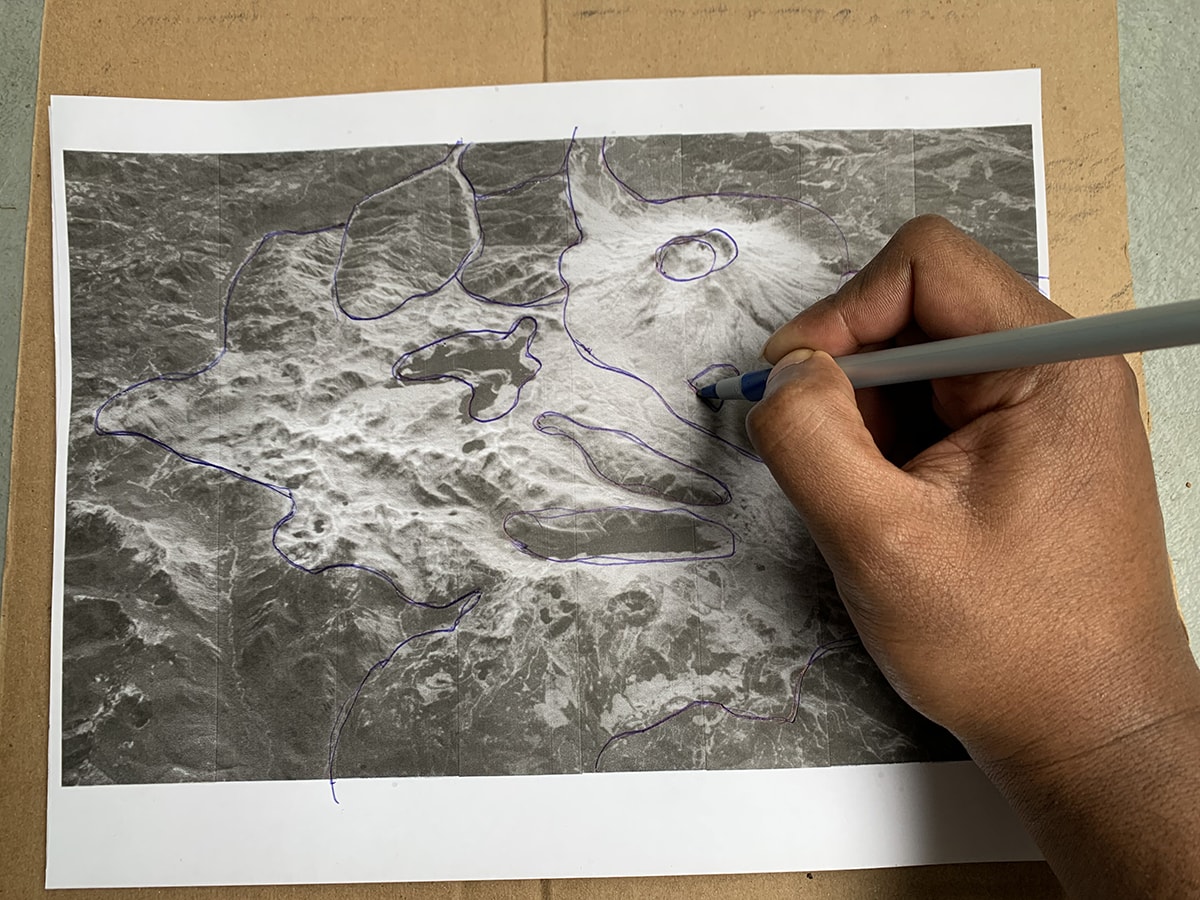Adapted from a Portland Public Schools Arts project
Inspired by the exhibition Volcano! Mount St. Helens in Art
Download the PDF or follow the instructions below.
In the centuries before the development of aircraft, mapmakers relied on a largely imagined aerial—or “bird’s eye view”—perspective to depict their surroundings. To twentieth-century artists, being able to fly in a plane or view aerial photography opened up a whole new way to create landscape art. These artists coined the term “aeropainting,” and it appealed to realist and abstract painters alike.
Mount St. Helens and the picturesque landscape surrounding it inspires unique emotions and meaning in each person who sees it. In this activity, we’ll use an aerial image of Mount St. Helens to create an abstract, layered artwork. The goal is to have fun creating art while getting a better understanding of how the natural world can change our perspectives and inspire creativity.
MATERIALS
- Construction paper (Personal preference, but white or black works best for us!)
- Charcoal (White or black depending on color of construction paper).
- If you don’t have any, a colored pencil or some chalk works great, too.
- Printed map or aerial photograph of Mount St. Helens from examples below or another source.
- A piece of foam or a pad of paper that fits the printed image you’re using.
- Ballpoint pens to emboss the paper and imprint the image.
- Watercolors or colored pencils. Any kind of paint works!
- Brushes and water cups for painting.
INSTRUCTIONS
Step 1:
Look at photographs, paintings, and maps of Mount St. Helens in the online exhibition of Volcano! Mount St. Helens in Art and below. Pay particular attention to images that look down on the volcano from above.

Step 2:
Compare the images and make observations about the visual characteristics you see. What natural lines and shapes do you see in each image? What different things do you notice about the volcano depending on the viewer’s perspective? Think about how these shapes and lines will translate to your painting. Choose one image to design your painting off of and print it out to move forward.

Step 3:
Place the printed image over your construction paper, and place the two sheets on top of your paper pad/foam. Use a ballpoint pen to transfer the key lines, shapes, and characteristics you’ve chosen from your image to the construction paper. Gently trace out the shapes with your pen to imprint the image onto the construction paper underneath.
- Younger artists may need some help learning how to gently press and transfer the image. You can also place an additional sheet of printer paper between the construction paper and the notepad/foam to prevent tearing.
Step 4:
Remove the image to reveal your construction paper. With the construction paper still on top of the paper pad/foam, rub your charcoal/chalk over the paper to reveal the shapes/lines you embossed into the paper.
- If you used black construction paper, use white charcoal/chalk to emboss the image. If you used white paper, use black charcoal. Be sure the colors contrast so you can see the image’s impression. The lines can be faint, especially if you’re not using charcoal. Tracing them can help make them more visible

Step 5:
Add color with your paints/colored pencils. The colors don’t have to be the same browns, greens, and grays as the real Mt. St. Helens. Instead, try to use colors that reflect the grand nature and power of the Volcano.
- Use a thin wash if using watercolors.

Your painting isn’t meant to be a perfect portrait of Mt. St. Helens, but to be a reflection of the volcano and your perspective of it. Draw and paint whatever comes to mind, and try to represent the emotions and thoughts you have surrounding Mt. St. Helens. Clear your mind, relax, and have fun with this exercise!

RECOMMENDED RESOURCES
Portland Public Schools art teachers developed this project for the HeART of Portland: A PPS K-12 Arts Showcase, which would have been held at the Portland Art Museum in spring 2020. The teachers took inspiration from the exhibition Volcano! Mount St. Helens in Art, especially Emmet Gowin’s aerial photography, and from maps in the Learning Space, designed in collaboration with the Mount St. Helens Institute.
ADDITIONAL VIEWS OF MOUNT ST. HELENS







